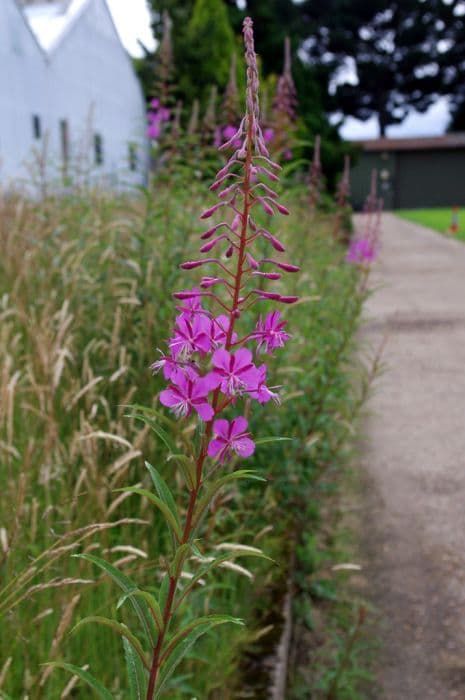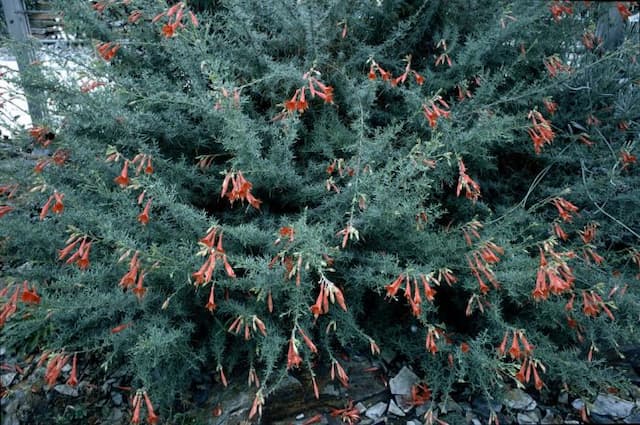Fuchsia 'Brookwood Belle' Fuchsia 'Brookwood Belle' (d)

ABOUT
'Brookwood Belle' is a cultivar with strong, upward growth and large flowers having red sepals and very full, double white corollas
About this plant
 Names
NamesSynonyms
Lady's Eardrops, Fairy Bells
Common names
Fuchsia 'Brookwood Belle'
 Characteristics
CharacteristicsLife cycle
Perennials
Foliage type
Deciduous
Color of leaves
Green
Flower color
Pink
Height
1-2 feet (30-60 cm)
Spread
1-2 feet (30-60 cm)
Plant type
Shrub
Hardiness zones
6-9
Native area
Central and South America
Benefits
 General Benefits
General Benefits- Ornamental Value: Fuchsia 'Brookwood Belle' features striking pendulous blooms, adding visual interest to gardens and landscapes.
- Attracts Pollinators: It serves as a nectar source for bees, butterflies, and other beneficial pollinators.
- Versatile Planting: Suitable for containers, hanging baskets, and border planting, offering flexibility in garden design.
- Shade Tolerance: The plant performs well in partial shade, providing color in areas of the garden that get less sunlight.
- Long Flowering Period: Known for its long blooming season which can extend from spring through fall in the right conditions.
- Hummingbird Friendly: The tubular flowers attract hummingbirds, bringing additional wildlife interest to the garden.
- Easy Pruning: Fuchsias can be easily pruned to maintain shape and encourage bushier growth and more blooms.
 Medical Properties
Medical PropertiesThis plant is not used for medical purposes.
 Air-purifying Qualities
Air-purifying QualitiesThis plant is not specifically known for air purifying qualities.
 Other Uses
Other Uses- Fuchsia 'Brookwood Belle' can be used in bonsai art due to its attractive flowers and the possibility of shaping its delicate branches into miniature tree forms.
- This plant's striking blooms can be used as natural dye for fabrics, yielding hues from pink to purple depending on the processing.
- Its pendulous flowers are an inspiration for jewelry design, with artisans crafting earrings and necklaces that mimic their unique shape and coloration.
- Fuchsia petals can be crystallized with sugar and used as edible decorations for cakes and desserts, providing a touch of elegance.
- As a teaching tool, Fuchsia 'Brookwood Belle' can be used in educational settings for lessons on pollination and the relationship between flowers and pollinators.
- The plant's rapid growth and responsiveness to pruning make it suitable for horticultural therapy programs, fostering relaxation and therapeutic engagement through gardening.
- It can serve as a natural insect attractant in a balanced garden ecosystem, drawing beneficial pollinators to the area.
- The blooms are sometimes used in the craft of flower pressing, where they are preserved in books and later used for art projects.
- During festive seasons, the bright flowers of Fuchsias are used to create lively, natural decorations and wreaths that add a pop of color to celebrations.
- Given their attractive appearance, Fuchsia flowers can be floated in water bowls as part of table centerpieces for outdoor garden parties or receptions.
Interesting Facts
 Feng Shui
Feng ShuiThe Fuchsia is not used in Feng Shui practice.
 Zodiac Sign Compitability
Zodiac Sign CompitabilityThe Fuchsia is not used in astrology practice.
 Plant Symbolism
Plant Symbolism- Confiding Love: The delicate hanging blossoms of the fuchsia plant are thought to represent confiding love, suggesting a deep emotional connection and a sense of trust between individuals.
- Good Taste: The elegant appearance of the fuchsia flower, with its beautiful color combinations and graceful form, is often associated with good taste in aesthetics and design.
- Ardent Affection: The vibrant and rich colors of the fuchsia can symbolize a passionate affection, indicating a love that is intense and fervent.
- Amiability: Fuchsia, being a very decorative and social plant often used in hanging baskets and gardens, can represent amiability and a welcoming demeanor in social situations.
- Elegance and Grace: The unique shape and poise of the fuchsia blooms are reminiscent of elegant and graceful movements, therefore symbolizing these attributes in the plant’s bearing.
 Water
WaterLady's eardrops, commonly known as Fuchsia 'Brookwood Belle', prefer consistent moisture, so it's important to keep the soil evenly moist but not waterlogged. During the growing season, water the plant thoroughly approximately twice a week, but adjust based on temperature and humidity levels. Make sure the top inch of soil dries out slightly before the next watering. Generally, you can provide about one gallon of water per week to maintain proper moisture levels. In hotter months or if the plant is in a windier location, you might need to water more frequently to prevent the soil from drying out completely.
 Light
LightLady's eardrops thrive in bright, indirect light with protection from the intense afternoon sun. A spot that receives morning sunlight with dappled shade in the afternoon is ideal. Indoors, place the plant near a window with sheer curtains to diffuse the light, ensuring it doesn't receive direct sun that could scorch its leaves.
 Temperature
TemperatureLady's eardrops do best in cool to moderate temperatures and should be protected from extreme heat. The ideal temperature range for Fuchsia 'Brookwood Belle' is between 60°F and 75°F. These plants can tolerate minimum temperatures down to about 40°F but should be sheltered from frost. Maximum temperatures shouldn't exceed 85°F for prolonged periods, as high heat can cause stress and damage to the plant.
 Pruning
PruningPruning Lady's eardrops encourages bushier growth and more flowers. After the main blooming season, cut back about a third of the plant to promote healthy new growth. Prune out any dead or diseased wood as needed throughout the year, and deadhead spent flowers regularly to encourage continuous blooming. The best time for major pruning is late winter or early spring before new growth begins.
 Cleaning
CleaningAs needed
 Soil
SoilFuchsia 'Brookwood Belle' thrives in a soil mix that is rich, moist, and well-draining with a pH range between 6 and 7. A good mix can consist of 1 part peat, 1 part loam, and 1 part perlite or sand to improve drainage.
 Repotting
RepottingFuchsias, including 'Brookwood Belle', generally need repotting every 2-3 years, or when they outgrow their current pot. It's best to repot in the spring.
 Humidity & Misting
Humidity & MistingFuchsia 'Brookwood Belle' prefers high humidity levels, ideally between 60-70%. To maintain these levels, especially indoors, a humidifier or regular misting can be helpful.
 Suitable locations
Suitable locationsIndoor
Place in bright, indirect light and ensure high humidity for indoor Fuchsia.
Outdoor
Use a shady spot, protect from wind, and keep soil consistently moist for outdoor Fuchsia.
Hardiness zone
6-9 USDA.
 Life cycle
Life cycleFuchsia 'Brookwood Belle' begins its life cycle as a seed, which germinates in damp, well-draining soil with partial shade once exposed to the appropriate environmental conditions. As a young plant, it rapidly develops roots and shoots, in optimal conditions, progressing to a bushy growth habit with vibrant green, ovate leaves. During the flowering season, which typically spans from spring through fall, it produces hanging, trumpet-shaped flowers, with a fusion of purple and pink hues that attract pollinators such as hummingbirds and bees. After pollination, if successful, the flowers will give way to small, dark-colored berries that contain seeds, completing the reproductive cycle. As a perennial, Fuchsia 'Brookwood Belle' enters a period of dormancy during the colder months, where growth slows dramatically and it may lose some or all of its leaves depending on the severity of the winter. With the return of warmer temperatures and longer daylight hours in spring, the plant emerges from dormancy, sprouting new growth and beginning its cycle anew.
 Propogation
PropogationPropogation time
Spring-Early Summer
Fuchsia 'Brookwood Belle', commonly known as fuchsia, is generally propagated during late winter to early spring, just before new growth begins. The most popular method is through softwood cuttings, which are taken from new growth that is not yet firm. A gardener would typically cut a 2 to 4-inch (5 to 10 centimeters) long stem, just above a set of leaves, and remove the bottom half of the leaves to expose the nodes. The base of the cutting is then dipped in rooting hormone and planted in a mixture of peat and perlite or a similar well-draining propagation medium. The cutting should then be placed in a warm, humid environment with bright, indirect light until roots develop, which usually takes about 3 to 4 weeks. During this time, the medium should be kept moist but not waterlogged to prevent rot.









